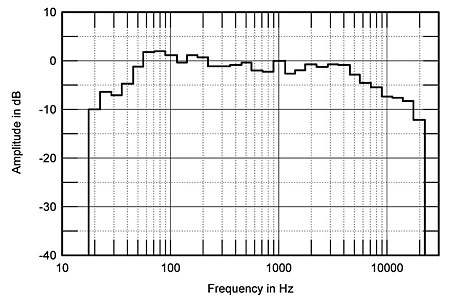| Columns Retired Columns & Blogs |
The Fifth Element #35 JA Measures the Concert Grands
Sidebar 2: JA Measures the Concert Grands
Intrigued by John Marks' expressions of satisfaction with the sound he was getting from the Concert Grands, I drove up to Rhode Island just before Christmas to hear the speakers for myself. Killing two birds with one stone, the trip would allow me to pick up the sample of the Plinius SA-REF amplifier to perform the measurements to accompany Paul Bolin's forthcoming review. And to make it three birds, I also took along the sample of the dCS P8i SACD player that I review elsewhere in this issue, so John and I could compare it with the EMM Labs gear.
The sound was indeed superb, with solid stereo imaging, impressive soundstage depth, a richly detailed midrange, and very well-defined low frequencies. It seemed a good opportunity to measure the ESP's in-room response with my standard procedure. Using an AudioControl SA305A spectrum analyzer and an EarthWorks QTC40 omnidirectional microphone, I took six 1/3-octave response curves for left and right loudspeakers individually at nine positions covering an approximately 48" by 18" spatial "window" centered on the position of John's ears when he was sitting on his couch. The 108 individual curves were then averaged, with a slight weighting toward the actual listening position. I have found this technique to give a benchmark response that eliminates the effects of LF room resonances to a large degree, and includes enough of the room sound with that heard direct from the loudspeaker for it to correlate very well with a loudspeaker's subjectively perceived tonal balance.
The result for the ESP Concert Grands is shown in fig.1: the premature LF rolloff is partially due, I believe to John's open-plan room not providing the expected boundary support at low frequencies. At the other end of the spectrum, the design's natural toe-in, coupled with the wide baffle restricting the tweeter's top-octave dispersion and the excessive acoustic damping of John's room in the treble, contributes to a measured high-frequency response that is more shelved-down than I would have liked to have seen. (Because of the contribution of the room acoustics and the speaker's restricted radiation pattern, you shouldn't see a flat top-octave response in this kind of measurement. But you should see rather more energy in this region than you can in fig.1.)

Fig.1 ESP Concert Grand SI, spatially averaged, 1/3-octave response in JM's listening room.
Even with its second side-facing tweeters, I did think the speaker sounded rather mellow. On the positive side, however, fig.1 does reveal that the integration between the speakers and the room is superb from the mid-bass through to the mid-treble. Very impressive.—John Atkinson
- Log in or register to post comments




































